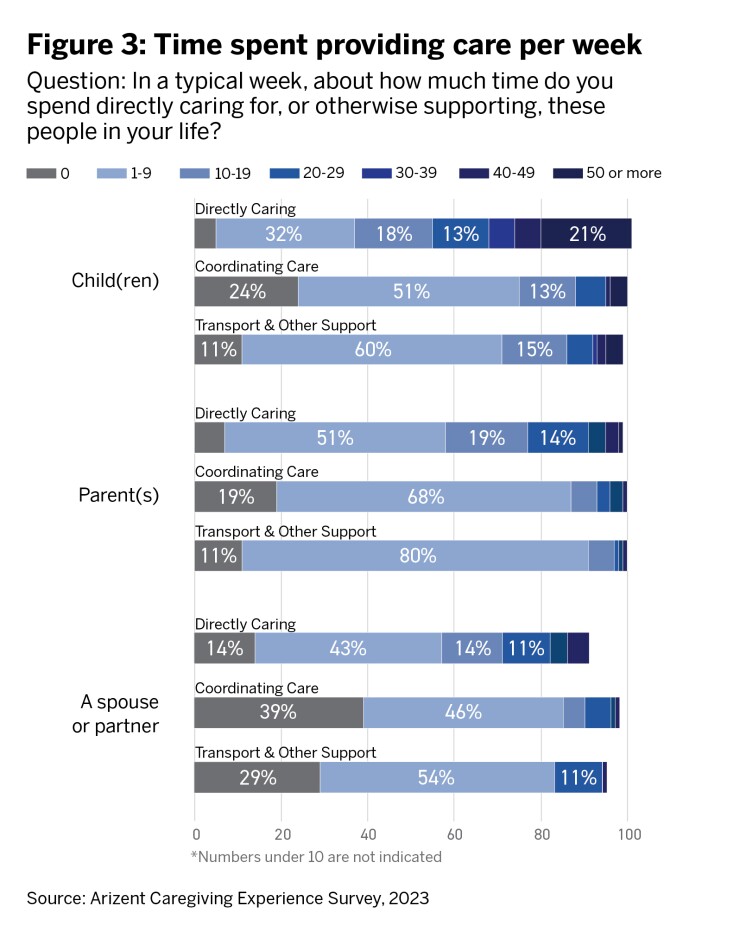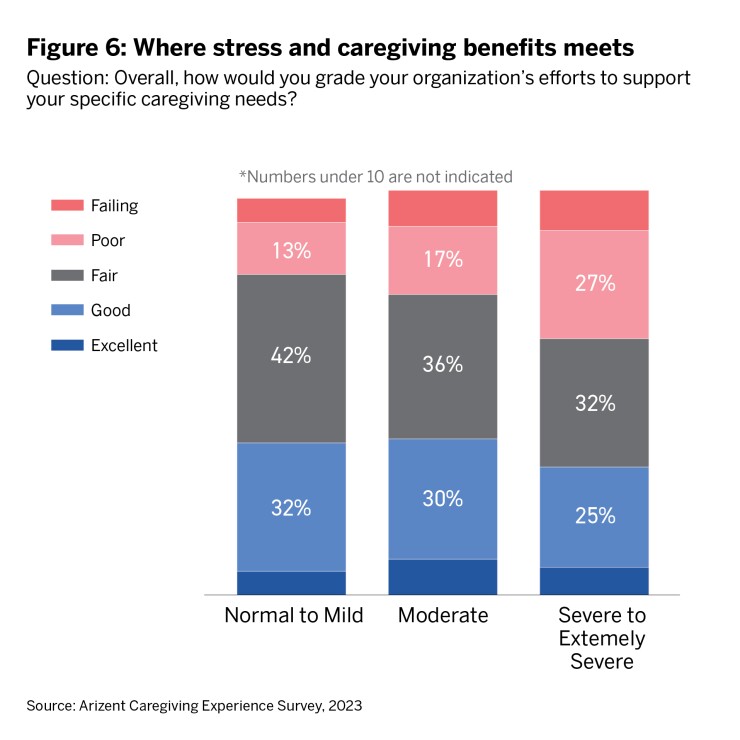The responsibilities that come with being a caregiver do not discriminate — nor does the toll they can take on an individual. Simply put: Those who are juggling professional responsibilities while providing care for a loved one need more support from employers.
Managing the care of a loved one, regardless of their age or condition, can have a substantial impact on a caregiver's
New research from Arizent, parent company of Employee Benefit News, gathered feedback from workers currently caring for other family members and loved ones to help employers know where to step up their benefits and policies to keep employees present and productive at work. Employees report that a lack of overall support is the main driver of the stress, fatigue and anxiety that can ultimately lead to them leaving their job. Further, they state that this imbalance can be addressed by employers with better communication, learning and the right benefits. Though more employers are making progress with these steps, more effort must be put into making sure their employee caregivers are not walking this journey alone.
Read more:
Despite the significant (and growing) population of caregivers in the U.S., fewer than one in five say their company is providing dedicated resources to support their caregiving obligations, and many are walking away from their work in order to give the time and attention their loved ones need.
Millennials and Gen X employees make up roughly three quarters of the workforce. For these groups, the likeliest form of caregiving is related to parenthood. Baby boomers, who make up 25% of the workforce, are more likely to be caring for a spouse or partner. More than a third of each of these groups report caring for aging parents, and these numbers will only go up.

A higher number of women have traditionally taken on the role of caregiver for their loved ones, and this trend remains, as out of the 500 survey participants, 62% were women (Figure 1). As the number of caregivers leaving the workforce has increased, female employees have been leaving their positions at all levels in droves.

Of all employees surveyed, the majority care for a child/children (42%), a parent (37%), or a spouse or partner (29%) (Figure 2). Adding to the already demanding job that working caregivers face, many have found themselves in the "sandwich generation," where they are taking care of both their children and an adult loved one at the same time.
Caregivers are working unpaid overtime
While caring directly for children as well as coordinating care and transportation understandably adds up to the highest amount of caregiving hours reported by respondents, 42% reported spending more than 10 hours per week on direct care for parents, with some spending north of 50 hours per week (Figure 3). Additionally, 68% spend up to 10 hours coordinating care, and 80% spend the same amount of time on transportation.

Employees caring for partners and spouses reported spending slightly less time on direct care, but also say they devote a fair amount of time per week to coordinating care, transportation and additional support duties.
Though the median monthly spend reported by respondents may not seem exceptionally high — $250 for a child or children, $200 for a parent or parents and $138 for a spouse or partner — the additional strain of out-of-pocket expenses can add up to be devastating for employees (Figure 4). Benefits such as health insurance, caregiver reimbursement and increased PTO can be a lifeline for workers who are assisting a loved one financially.

Caregivers know what kinds of support would make them more effective, and allow for a more manageable
assistance with day-to-day tasks such as household services were trending responses.
Read more:
Direct care support, by far the most common response at 39%, means different things to caregivers depending on their needs. Access to an additional support person or caregiver was the top response at 18%, followed by simply needing a break. Together, they exhibit what employees are desperately trying to communicate: they need to feel like they're not in this alone.
Not enough employers are getting it right — and it's driving turnover
Fewer than one in five respondents say their company is providing dedicated resources to support caregivers. But, those with a strong workplace support structure give good insight into what works. Robust health insurance that employees can extend to their children under the age of 25 was respondents' top area of satisfaction, with 66% saying this employer-provided benefit mostly or fully meets their caregiving needs.
The largest shortcoming is among caregivers taking care of their parents, with almost half saying their employer does not provide the support they need. Nearly 40% of those caring for partners and spouses and just over 30% of parents said the same. This is despite over half of all respondents saying their manager is aware of the scope of their caregiving responsibilities, signaling a disconnect in communication and action.
Read more:

We asked, "What kind of employer support would make your caretaking for the people in your life easier?" Respondents' specific answers are tracked below, in Figure 5:
There is a direct correlation between applicable benefits and stress and anxiety reduction among employees. Of employees who reported a severe to extremely severe amount of stress, 37% gave their employer a grade of "poor" or "failing" when it comes to caregiver support. In contrast, of employees who reported a normal to mild amount of stress, just 19% gave their employer a "poor" or "failing" grade (Figure 6).

Working caregivers who say their employer supports them are substantially less likely to move on from their job. Seven out of 10 caregivers say they'd be open to a new role, but among employees who gave their company an "A" on caregiver available support, 50% report not being open to a new role at this time (Figure 7). The needs of working caregivers must be a priority if employers are to avoid increased turnover and disengagement within their workforce. High stress and anxiety levels drive burnout and attrition, and workers are looking for resources that offer relief, empathy and overall well-being support.

Caregiving duties take time and money. Flexibility, PTO, financial assistance and platforms that help workers navigate the schedules and healthcare needs of their loved ones are specific benefits that cater directly to the needs of a caregiver population.
Those benefits that help ease the duties taken on by employee caregivers have the greatest impact on worker satisfaction. Employers that offer multi-tiered support to their caregiving population are better able to






